Questions Answered by N. R. Woodward
Author of The Glass Insulator in America
Reprinted from "INSULATORS - Crown Jewels of the Wire", June 1973, page 2
William Davis of West Babylon, New York writes: I recently acquired an
insulator that I would like to inquire about. It is a CD 295 Hemingray 72, but
it is not embossed as shown in any of the reference books I have. It appears
to be a mold change from a No 4 high voltage.
The embossing on the front is as
shown for a No 4 H.V. -- HEMINGRAY / PATENTED MAY 2
1893
The embossing on the back is: HIGH VOLTAGE
/ MADE IN U.S.A. / No 72
I can discern some letters under
"MADE IN U.S.A.", and I'm positive this was struck over TRIPLE
PETTICOAT - some of the original letters were utilized in the change. Also the
number 4 is quite obvious under the 7 in 72.
I know that mold changes and strike overs are not that uncommon, but I would
like to know if this adds anything to the rarity of an insulator. One can't help
but wonder how many of this particular specimen were produced before one of the
known listed variations emerged. Thank you for any light you may be able to shed
on this.
- - - - -
In reply to William Davis: Your No. 72 with the traces of previous mold
engraving is interesting. That particular insulator went through several
changes; and evidently the molds weren't used continuously enough that they wore
out, so they were simply re-engraved and used over a long period of time. As I
have stated before, these remnants of previous engraving are most valuable in
that they prove beyond a doubt the order in which various numbers and lettering
arrangements were used. Beyond that, it would seem impractical to make a blanket
statement as to increased value due to this detail. If a sufficient number of
collectors were to specialize in these, their prices would no doubt Increase. As
of now I do not know of such a demand.
Question from Charles Bullock, Waukegan, Illinois: I would like to know if
you could supply me with any information on the following insulator. It is a
very light green H. G. Co. beehive. The embossing is what is so curious. There
is an A on the crown instead of an H. The front says H. G. CO., and the back has
PETTICOAT with an A under it Thanks.
- - - - -
In reply to Charles Bullock: The H. G. CO. / PETTICOAT series of CD #145 is
most interesting. This is the first of this style by Hemingray; and, although we
can't prove it in any way, it would seem to surely be Covington production. The
A is a mold letter. This series is found with letters A to N. Sometimes they
appear in one place on the insulator, sometimes in another, and sometimes (as
the one you have) they appear on both crown and skirt.
Your mention of this insulator gives me a chance to speak of one of my
favorite mold sets. What a fine "specialty" collection these would
make! First looking for all the molds, then looking for as many colors of each
as could be found, would go on forever and make a very colorful shelf. Evidently
cullet was used, as they came in all colors. And yet, with the exception of the
ambers and purples, they are not rare enough so that one would need to invest a
great deal in such a display.
Ed (???) writes: Have found four CD 115 Hemi 10, all light pink and all with
this design on top. Would like to know if any other readers have any like this,
also what they are worth.

- - - - -
The pink Hemingrays were made 1941-42. The "design" on the crown
wasn't intended, but is where the glass folded together in the bottom of the
mold during filling of the mold. These folds are created where the surface of
the glass begins to cool slightly. This group is rather common, and I know of no
particular value being attached to them.
Don Kenyon of San Dimas, California states: I have come across an insulator
which I hope you can give me some information on. It is a Whitall Tatum Co. No.
5, and, though the mfg. number is in Milholland's book, I cannot find the same
design in Milholland, Tibbits or Hill. I guess the closest to it in C. D. is
either C. D. 167 or 168. It must seem trivial to you with all your knowledge of
insulators, but please answer this for my curiosity. (sketch below)
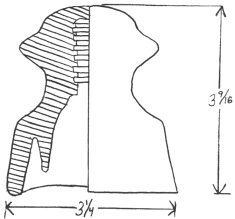
- - - - -
In reply to Don Kenyon: The Whitall Tatum No. 5 shown is the CD #165.1. It
was previously listed as CD #165 along with the new style Hemingray - 20 (1941
and 1942 mold sets): but design of the crown is a bit different, and it has been
given its own number.
From Jerry Gibby: I have acquired two insulators recently, and I have no
info. on them. Maybe you can help shed some light on them, and maybe their
value. Thank you.
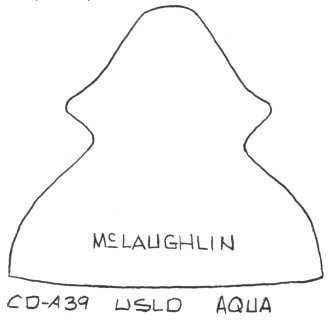 |
Same dimensions, but a pointed top. |
| LYNCHBURG - Note spelling and smooth base - Aqua.
Back - NO. 36 - U.S.A. |
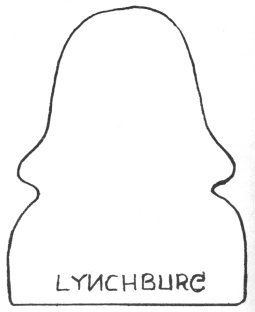 |
- - - - -
In reply to Jerry Gibby: Nothing is known as to the USLD Insulators; and this
slight variation in crown formation probably had no significance.
According to the brochure prepared by Lynchburg Glass Corporation, insulators
were made with drip points unless the buyer requested a smooth base rim. In the
case of No. 36, quite a few buyers evidently did request the smooth base, as
they are fairly common. You did not list the mold number; but all of that number
in that mold set would have the backward N. This would be one-eighth of the
production during the time that mold was used, assuming it was an 8-mold press.
Mrs. J. P. Swift, Box 477, Gardnerville, Nevada 89410 has a question on
several insulators:
Insulator A - CD 102 - No Name - No embossing. Light aqua, tiny bubbles -
three piece mold - thick base - crude - large size measuring 2 5/16 wide - 3 3/4
tall - near mint. Threads are not long like the one identified as "D"
on page #39 in the OBM, September 1972 issue. It does not have wide mold seams.
Near mint.
Insulator B - CD 112 - No Name - No embossing. Light aqua, tiny bubbles -
three piece mold - thick glass - small spot of glass underside of dome just
above top of threads. This insulator appears to be identical to a CD 112 that I
have in my collection which is embossed S.T.B.& T.Co. I cannot tell them
apart except for the embossing. Near mint. Size 3 1/2" in height - 2
1/4" in width.
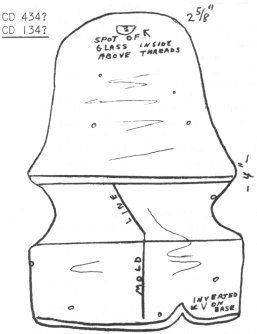
Insulator C - CD 434?? or CD 134?? (Sketched at left.) No Name - No
embossing. Light aqua, tiny bubbles three piece mold - small spot of glass
underside of dome just above top of threads. The mold lines seem to fall to the
left through the wire groove approximately a distance of 1/2 Inch. Small upside
down V on one half mold on the base making it appear to have a chip on it,
but it is where the glass did not meld correctly. Near mint. Size 4" in
height 2 5/8" in width.
Insulator D - (Sketched on page following) - CD 152 Front B - Back 1/2
horizontal slash bar on skirt. Olive green - near mint. The "B" and
the "slash bar" are not centered on each half mold. They are about
one-third of the way over from one of the mold lines.
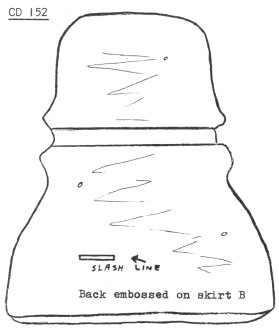
We so much enjoy each and every article in the Crown Jewels, and are
especially interested in the research articles. I know you are very busy, but I
am hoping some of your readers might also be interested in the above insulators.
Other collectors probably have at least one of them somewhere. We would be happy
to answer all correspondence from any of your readers.
The CD 152 I came across in an antique store in Nevada. The CD 102, 112 and
134 were bought in Alaska last July.
Are the small spots of glass unusual in insulators? Could you tell me if
these are unusual insulators; and does anyone know who made them, including the
CD 112 S.B.T.& T.Co.? I would appreciate any more information on any of them.
- - - - -
In reply to Mrs. J. P. Swift: The unmarked insulators with generally light
green bubbly glass are unidentified. I feel as you do, that beyond a doubt the
same glass works made the S.B.T.& T. CD #112, as it does exactly match the
unmarked ones. This association has led to speculation that the plant may have
been in one of the southern states in S.B.T.& T. territory. But there are two
or three other styles as well that seem to fit this same source; and they come
from all over. And you say that yours came from Alaska! It will be a miracle if
we ever get positive identification on these.
As to the points of glass at the top of the pin hole; these have no
significance and are where the mandrel was held in a chuck during machining.
Betty Lacey, University, Alabama writes: In reference to your reply to a
question from Elton and Lynda Gish of Port Neches, Texas on page 4 of the
January 1973 issue of Crown Jewels of the Wire, I believe I have some additional
information. This concerns the Brookfield mold set of extra heavy glass and
larger base diameter than is usual in Brookfield CD 145.
I have what I believe is a number 1 of this series. The heavy glass and
larger base are identical (I also own Nos. 2 and 4). The front is marked with a
B, the back with a 1, and there is a B on top of the crown. Just thought you
might like to know.
- - - - -
In reply to Betty Lacey: Thanks for reporting the "1" of this set.
Someone else has also reported one of these--so that makes a set of four. Are
there any others?
Paul Greaves of Carmichael, California states: I have two insulators I would
like your opinion on. One is a CD 208 Hemingray No 44 and the other is a CD 133
H. G. CO. / PAT. MAY 2, 1893 STANDARD. Both of these insulators are what I've
been told to be a "Peacock Blue". The two I have are both damaged on
the drip points. I have not been able to find this color variation in any books
I have. Can you give me some information on how rare (or common) these two are?
I also have a HEMINGRAY No 12, PAT. MAY 2, 1893 CD 113 in jade milk swirl. I
haven't seen the No 12 (in milk) at any shows, nor is it listed in my book. It
is a beautiful color and makes a good display piece for my window shelf. I would
sure appreciate any information you have.
- - - - -
In reply to Paul Greaves: The variations in shades of blue and aqua in the
Hemingray insulators are very difficult to describe and to reach a perfect
understanding with another collector. Since the CD #208 and #133 are not the
most common styles to begin with, I imagine an unusual variant in color would be
difficult to match and could be called "rare". However, whether this
would greatly increase their commercial value would depend on whether that
particular color appealed to a particular buyer.
The milky swirls in the common styles of Hemingrays are not too unusual, as
No. 9, 12, 16, 19, 20 and perhaps others. But they are attractive and would be
in demand far more than a plain aqua color.
Steven A. Wakefield writes: I'd like to thank Mike Cheuvront for sending in
the picture of the Brookfield signal. I think the picture makes a good case
for a new C. D. number. I have a theory which might explain the use of this
particular Brookfield. I found mine on a four-point transposition bracket. In
fact, the only ones I've seen were on a tramp. bracket. I think that the wire
groove ridge and "shelf" (above the groove) were designed to offset
the extra strain exerted on a 4-point tramp. insulator. The thicker shelf and
deeper groove also prevented the insulator from jumping its groove.

With the two Mike mentioned, that makes five I know of--all from the same
lead. I'd like to know if Mr. Woodward would be willing to assign a different C.
D. number for this insulator.
- - - - -
In reply to Steven Wakefield: As regards the Brookfield in question, It looks
as if it does need a new CD number (a decimal number); but I would have to see
the insulator itself first.
However, it wouldn't be designed for use on a point transposition such as
suggested. Point transposition brackets of this general style were first used on
Bell System carrier circuits in the late 1920's years after Brookfield went out
of business. These were used exclusively with CD #128 and other carrier
insulators. The modified style was used by the railroads and Western Union in
post World War II and when they were put up, whatever insulators were on the
arms were used, with ordinary Hemingray - 45 used as needed. No special
insulators were used with these.
From a mechanical standpoint, no special requirements are involved for point
transpositions, since the compression strength of glass is very great, and as
long as the insulator is properly mounted on the cob, it isn't under any
particular strain other than the lateral pressure of the wire. And so far as
needing an extra deep groove to hold the wire in place- -did you ever try to get
an insulator out of a transposition without removing the tension first from the
line?? 'Nuff said.
| 